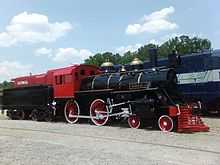Louisiana Eastern Railroad
| Louisiana Eastern Railroad | |
|---|---|
| Reporting mark | LE |
| Locale | Midwestern to Gulf Coast, United States |
| Dates of operation | 1947–1963 |
| Track gauge | 4 ft 8 1⁄2 in (1,435 mm) (standard gauge) |
The Louisiana Eastern Railroad was a proposed railroad that was to serve as an alternate line bypassing the congested rail lines in New Orleans, LA. The railroad was envisioned by Paulsen Spence in the late 1940s and early 1950s, and while most US railroads had or began to replace their steam locomotives with diesel locomotives, the LE was to operate exclusively with steam locomotives which Spence had collected over time. He died in 1961, and the railroad had never fully materialized.
History
Paulsen Spence, an entrepreneur who had patented steam valves, started a gravel industry in 1947, with a rail spur leading to an area which he had named "Sharon Junction" where the spur connected to the Illinois Central Railroad's main line. This spur, known as the Comite Southern, was operated using retired steam locomotives and served as the basis for the Louisiana Eastern.
In 1950, Spence purchased another industrial spur, known as the Gulf & Eastern Railroad, which also served a gravel plant and connected to the Illinois Central at Shiloh, LA. This line had been formed in 1946 and already operated a retired steam locomotive.
These two lines had been combined under the title of the Louisiana Eastern Railroad, and were soon upgraded, with heavier rails and reconfigured switches. Throughout the 1950s, Spence had continued to collect steam locomotives that had been retired from main line railroads when they started to switch to diesel motive power. Ultimately, over thirty steam locomotives of various designs had been acquired for the road, transporting gravel to the Illinois Central as well as occasional excursion trains for railfans who admired the railroad's use of steam engines until the 1960s.
The railroad's demise
Paulsen Spence died in 1961, and thus his vision of a through freight line operated with steam locomotives had never been realized. Upon his death, there had been very little interest by others in maintaining the railroad and its engines. The last train operated in 1963, with all but four of its locomotive scrapped shortly thereafter, marking the end of a unique short line.
Preserved equipment
Of the collection of over thirty steam locomotives, only four survive today. These engines are:

- Number 1, 4-4-0, built by the Baldwin Locomotive Works in 1919 as Red River and Gulf number 104. Was sold to the Stone Mountain Scenic Railroad where it was given the name "General II" and operated until 1986. The locomotive was donated to the Southeastern Railway Museum in 2007, where it is presently displayed.

- Number 2, 4-4-0, built by Baldwin in 1923 as San Antonio and Aransas Pass Railway number 60. Became the second number 1 after no. 1's sale before being sold to Stone Mountain as well. The engine was named the "Texas II" and operated until 1984. The locomotive was donated to the Gulf and Ohio Railways in 2012, where it is currently awaiting restoration for use on that railroad's Three Rivers Rambler tourist operation.

- Number 4, 4-6-2, built by Baldwin in 1928 as Gulf Mobile & Northern number 425. Currently owned by the Reading Blue Mountain and Northern Railroad where it operates on special occasions.

- Number 98, 4-4-0, built by ALCO in 1909 as a Mississippi Central locomotive of the same number. Currently owned by the Wilmington and Western Railroad where it operates on select weekends.
References
- Louis R. Saillard. "Paulsen Spence and the Louisiana Eastern Railroad". Railfan & Railroad, August 2009
External links
- Hawkins Rails site with pictures and information about the LA Eastern and other shortlines.
- Southeastern Railway Museum LE #1's current home.
- Friends of SA&AP #60(later LE#2)
- Reading and Northern LE #4's current home.
- Wilmington and Western Railroad LE #98's current home.